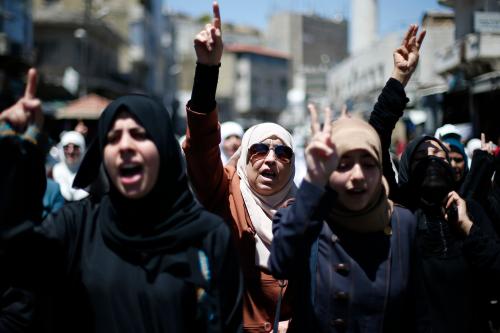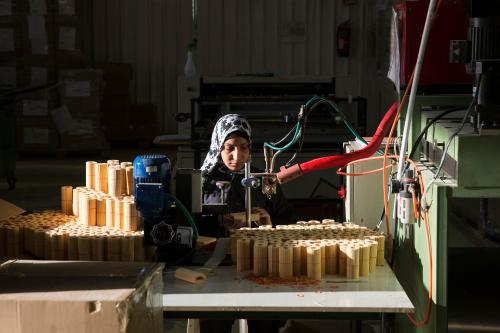Content from the Brookings Doha Center is now archived. In September 2021, after 14 years of impactful partnership, Brookings and the Brookings Doha Center announced that they were ending their affiliation. The Brookings Doha Center is now the Middle East Council on Global Affairs, a separate public policy institution based in Qatar.
Governments in the Middle East and North Africa (MENA) continue to search for ways to repair their fragile economies. For some countries in the region, experts wonder whether high unemployment and poor economic growth could precipitate another round of political upheaval, similar to the uprisings in early 2011.
Despite this ominous scenario, there is one strategy that MENA governments persistently overlook to ease economic pressures: increasing female employment, a topic that Bessma Momani explores in a recent Brookings policy brief. Momani explains that the lack of female representation in MENA workforces limits economic growth in the region. She also argues that government policies encouraging greater female participation in the workforce will have a host of other economic and social benefits, in addition to boosting GDP. Furthermore, Momani contends: “introducing diversity through gender parity will benefit economic growth and can help Arab countries generate prosperity—as well as the normative and social imperative of change.”
Unfortunately, as Momani outlines, several barriers impede women in MENA from joining the labor force. In order to counter this, in her view, MENA governments should conduct gender impact studies for regional policymakers to understand how policies shape cultural attitudes toward gender. MENA governments manage primary and secondary school curricula, which studies have shown contain direct and indirect gender biases in the national education curriculum. Momani’s research shows that such gender impact studies could expose the types of gendered language used in textbooks that help reinforce male-dominated workforces in the region. Government-sponsored internships allocated for women could overcome stereotypes in industries previously gendered as masculine, she adds.
Other factors that prevent women from entering the workforce in MENA countries include the following: low salaries, early retirement, underwhelming job benefits, difficulty securing capital for entrepreneurial ventures, and harassment in public spaces. By addressing these concerns in the short-term, Momani argues that regional governments will lay the foundation for economic prosperity in the long-term. Regional policymakers face an enormous challenge if they address these issues simultaneously. Nevertheless, with many economies in the region facing a grim outlook for 2017, she contends that it would behoove them to seriously consider policies that encourage more women to join the workforce.

Women’s full employment in MENA could increase household incomes by as much as 25 percent:
According to a World Bank report, “women’s employment can significantly improve household income—by as much as 25 percent—and lead many families out of poverty.” It continues that increased household income will not only positively impact MENA economies on the micro level, but it will bolster economies on the macro level as well. The IMF supports this claim by noting that from 2000 to 2011, the region
“could have gained $1 trillion in cumulative output (equivalent to doubling average real GDP growth during the past decade) if female labor force participation had been raised enough to narrow the gender gap from triple to double the average for other emerging market and developing countries.”
Momani’s new research indicates that such predictions remain relevant today.
Higher female employment rates could reduce poverty due to lower birth rates and improvements in child welfare:
As Momani further discusses, echoing other researchers, greater economic opportunity for women could contribute to reducing poverty. Research by the National Institutes of Health, for one, has shown that financially independent women demonstrate a greater ability to support their children, which greatly improves child welfare. Momani points to studies showing that women in the beginning stages of their careers—especially younger women, who make family planning decisions later in life—tend to have fewer and healthier children, as well as higher earnings, which can reduce poverty rates among youth.
Women-led households save more money:
Momani’s brief illuminates that as working women gain financial independence—and in some cases become the breadwinner of the family—they can gain more decisionmaking power in the family. As one gender equality study she cites argues: “Women’s propensity to save is greater than men’s, and women’s consumption focuses to a greater extent on the children and on household necessities.” As another report shows, this change in the household dynamic will also boost regional economic growth in the short-term, which will lead to sustainable economic development in the long term.
Even in households where financial responsibilities are shared equally among men and women, a cross-country panel study of semi-industrialized nations found “that an increase in women’s wage share relative to men is associated with increase in the domestic savings rate.” Whether women take sole responsibility of household financial matters or share this responsibility with their spouse, the benefits of this development will make families in MENA more fiscally secure, Momani shows.
If women were employed at the same rate as men, they would contribute $2.7 trillion to regional GDP by 2025, a 47 percent increase:
According to a McKinsey report, if MENA countries close the gender gap in the labor force, the region could see an additional $2.7 trillion added to MENA countries’ GDP by 2025. Momani concludes that Arab countries must overcome numerous cultural and societal challenges to stimulate increased female participation in the labor force, but by initiating policy changes that encourage a shift in this dynamic, MENA countries will find themselves more financially secure in the future.










Commentary
Why the Arab world should employ more women
February 6, 2017